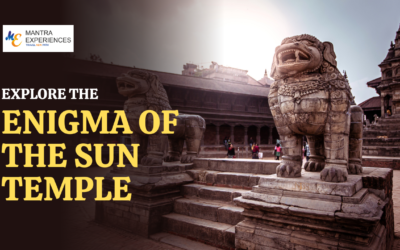Exploring the Magnificent Khajuraho Temple : A Journey Through Time
Nestled in the heart of Madhya Pradesh, the Khajuraho Temples are iconic masterpieces of Indian temple architecture. Constructed between the 9th and 11th centuries, these temples hold secrets and surprises that go beyond their stunning facade.
The Khajuraho Temples, a UNESCO World Heritage Site, are a marvel of ancient Indian art and a testament to the rich cultural heritage of India. Join us on this virtual journey as we delve into the architectural wonders, historical significance, and captivating mysteries hidden within these extraordinary temples.
The sculptures of the Khajuraho Temples
The sculptures of the Khajuraho Templesare renowned for their exquisite craftsmanship and intricate detailing. These sculptures are a defining feature of the temples and play a central role in their historical and artistic significance. Here’s a closer look at the sculptures of Khajuraho:
Diverse Themes: The sculptures at Khajuraho cover a wide range of themes. They depict scenes from Hindu mythology, including gods and goddesses like Shiva, Vishnu, and Devi. These sculptures also portray various aspects of daily life, including musicians, dancers, artisans, and even depictions of courtly and sensual activities.
Sensuous Imagery: One of the most distinctive and often talked-about aspects of Khajuraho’s sculptures is their sensuousness. Some of the sculptures depict erotic and intimate scenes, challenging conventional notions of spirituality and sensuality. These explicit carvings are found primarily on certain temples and are believed to symbolize the celebration of life and the union of the physical and the spiritual.
Architectural Integration: The sculptures of Khajuraho are seamlessly integrated into the architecture of the temples. They adorn the temple walls, doorways, pillars, and spires. The intricacy and precision with which these sculptures are carved make them an integral part of the temple’s overall design.
Artistic Skill: The craftsmen of Khajuraho were highly skilled artisans who demonstrated exceptional proficiency in stone carving. The sculptures exhibit remarkable attention to detail, with intricate facial expressions, delicate jewelry, and finely carved garments. The skill of these artisans is evident in the lifelike and emotive qualities of the sculptures.
Spiritual Symbolism: While some sculptures depict sensual and earthly activities, many others convey deep spiritual and religious themes. These sculptures serve as a visual representation of the rich mythology and spiritual beliefs of the time. They also highlight the connection between the physical and the divine in Hindu philosophy.
Storytelling Through Stone: Each sculpture at Khajuraho tells a story. Whether it’s the cosmic dance of Lord Shiva, the divine romance of Radha and Krishna, or scenes from the Mahabharata and Ramayana epics, these sculptures narrate the tales of ancient India in a visual language that transcends time.
Preservation and Restoration: Efforts have been made over the years to preserve and protect these priceless sculptures. The Archaeological Survey of India has been actively involved in their restoration and conservation, ensuring that future generations can continue to appreciate their beauty and historical significance.
The sculptures of the Khajuraho Temples are not merely decorative elements but serve as a window into the artistic, cultural, and spiritual life of ancient India. They continue to captivate and inspire visitors, scholars, and artists alike, offering a profound connection to the past and a timeless celebration of human creativity and expression.
History About The Khajuraho Temple
Once upon a time, in the heart of India’s vast and diverse landscape, stood a group of temples that would captivate the world with their timeless beauty and enigmatic sculptures. These temples, known as the Khajuraho Temples, held within their intricately carved walls a story that transcended centuries.
The year was 950 AD, and the Chandela dynasty ruled the region of Bundelkhand, in present-day Madhya Pradesh. It was during this time that a vision of spiritual devotion and artistic brilliance took shape in the form of the Khajuraho Temples. The Chandela rulers, inspired by their deep reverence for the divine and a desire to showcase their architectural and artistic prowess, embarked on an ambitious project of temple construction.
The Khajuraho Temples were built over several generations, with each ruler contributing to the complex’s expansion. Over time, the site grew to house more than 80 temples, but today, only 22 of them remain, scattered over a 6-square-kilometer area.
These temples were not just places of worship; they were living testaments to the culture and beliefs of the Chandela dynasty. Each temple was intricately carved with scenes from Hindu mythology, depictions of daily life, and sensuous imagery that challenged conventional notions of spirituality.
One of the most famous temples in Khajuraho is the Kandariya Mahadeva Temple. As the sun’s first rays touched its beautifully sculpted spires, the temple seemed to come alive with stories etched in stone. The carvings portrayed gods and goddesses, celestial nymphs, and ordinary mortals, all engaged in various acts of devotion, love, and life.
Despite the passage of centuries, the Khajuraho Temples remained remarkably well-preserved, a testament to the craftsmanship of their creators. However, they gradually fell into obscurity as the Chandela dynasty declined, and the temples were engulfed by the dense forests of the region.
It was in the early 19th century, during the British colonial era, that the temples were rediscovered by Captain T.S. Burt, a British engineer. As he cleared away the thick vegetation, the exquisite beauty of Khajuraho was unveiled once more, and the world was introduced to these architectural marvels.
In 1986, UNESCO recognized the Khajuraho Group of Monuments as a World Heritage Site, acknowledging their cultural and historical significance. Today, these temples continue to draw travelers, historians, and art enthusiasts from around the globe, providing a window into India’s rich past and its profound artistic achievements.
As visitors stroll through the serene and verdant grounds of the Khajuraho Temples, they can’t help but be transported back in time. The sculptures whisper tales of devotion, sensuality, and the eternal human spirit. In the midst of modernity, the Khajuraho Temples stand as a reminder of a bygone era, where art, spirituality, and life were intricately intertwined, creating a legacy that continues to inspire awe and wonder in the hearts of all who visit.
Historical Facts
Rich Heritage: The Khajuraho Temples are an embodiment of India’s rich cultural and artistic heritage during the Chandela dynasty’s reign.
Rediscovery and Restoration: Over time, these temples were forgotten and covered by forests. They were rediscovered in the 19th century and have since undergone significant restoration efforts.
UNESCO World Heritage: In 1986, the Khajuraho Group of Monuments was designated as a UNESCO World Heritage Site, recognizing their cultural and historical significance on a global scale.
Significance
Spiritual and Artistic Center: The temples were dedicated to various deities, including Vishnu and Shiva, and served as places of worship and artistic expression.
Architectural Legacy: They continue to inspire architects, artists, and visitors worldwide, showcasing the artistic prowess of ancient India.
Tourism Attraction: Khajuraho is a major tourist attraction in India, drawing visitors with its historical, architectural, and artistic allure.
Location
The Khajuraho Temples are located in the town of Khajuraho in the Chhatarpur district of Madhya Pradesh, India.
Weather Conditions
Summer – The summer months (March to June) can be hot, with temperatures often exceeding 40°C (104°F). It’s advisable to visit during cooler months.
Monsoon – The monsoon season (July to September) brings heavy rainfall, making it less favorable for a visit due to wet conditions.
Winter – The best time to visit Khajuraho is during the winter months (October to February) when the weather is pleasant and ideal for exploring the temples and the surrounding area.
Suitable Time to Visit
To fully enjoy your visit to the Khajuraho Temples, plan your trip during the winter months, ideally between October and February.
How to Reach
By Air – The nearest airport is Khajuraho Airport, which is well-connected to major cities in India. From the airport, you can hire a taxi to reach the temples.
By Train – The nearest railway station is Khajuraho Railway Station, which is connected to major cities in India. From the railway station, you can hire a taxi or take a local bus to reach the temples.
By Road – Khajuraho is well-connected by road to various cities in Madhya Pradesh and neighboring states. You can hire a taxi or take a bus from nearby towns to reach the temples.
Final Thoughts
Prepare for a captivating journey to the Khajuraho Temples, where art, history, and spirituality converge. Explore the intricate carvings, delve into the historical significance, and immerse yourself in the artistic legacy of these remarkable temples. When will you embark on your adventure to the exquisite Khajuraho Temples?
Itinerary Suggestions
Here are some itinerary suggestions for your visit to Khajuraho :
Ajanta and Ellora Caves
Ajanta and Ellora Caves: India's Ancient Artistic Treasures Tucked away in the heart of Maharashtra, India, the Ajanta and Ellora Caves are not mere geological formations; they are portals to India's rich cultural heritage and spiritual depth. Carved into the rocky...
Konark Sun Temple
Konark Sun Temple The Magnificence of Odisha's Iconic Gem Nestled in the heart of Odisha, the Konark Sun Temple is an iconic masterpiece of Indian temple architecture. Constructed in the 13th century by King Narasimhadeva to pay homage to the Sun God, Surya,...



